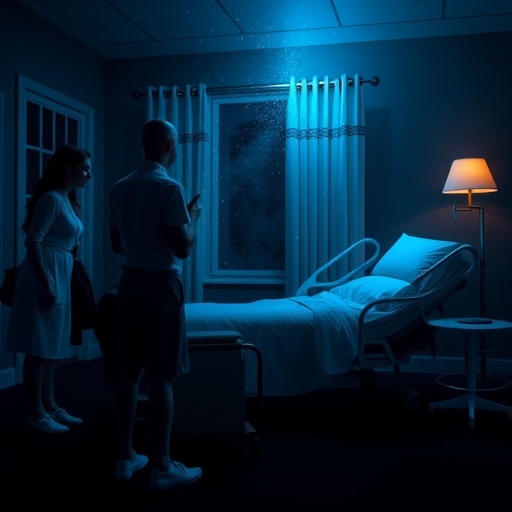Delirium, often referred to as an acute confusional state, is an enigmatic condition that has long perplexed healthcare professionals, particularly in long-term care settings. Recent research led by Rouabhia, Emond, and Pageau offers a profound exploration of this complexity, likening its multifaceted nature to the mythological Lernaean Hydra. The study delves into the myriad of factors contributing to delirium, shedding light on its etiology in environments where elderly populations are prevalent. This research is not just an academic exercise; it has significant implications for clinical practice and the wellbeing of our most vulnerable patients.
The prevalence of delirium in long-term care facilities is alarmingly high, often reaching up to 50% among residents. This statistic alone underscores the need for heightened awareness and understanding among caregivers and healthcare professionals alike. In these environments, where individuals may already be grappling with cognitive impairment, the onset of delirium can exacerbate existing issues and lead to a cascade of negative outcomes. The etiology of this condition is often multifactorial, necessitating a comprehensive approach to identification and management.
Among the contributors to delirium, the authors identify physiological, pharmacological, and psychological factors as critical elements. The physiological underpinnings of delirium can include metabolic imbalances, inflammation, and infections, all of which can manifest with sudden and varied symptoms. Understanding these physiological triggers is crucial for timely interventions, as they can often be reversible if detected early. Additionally, the role of polypharmacy, or the simultaneous use of multiple medications, cannot be underestimated. In long-term care settings, the older population frequently takes numerous medications, increasing the risk of adverse drug reactions that can precipitate delirium.
The environmental aspects surrounding residents in long-term care facilities also play a significant role in the development of delirium. Factors such as inadequate lighting, noise levels, and the overall lack of social interaction can contribute to a sense of disorientation and confusion for residents. The study emphasizes the importance of creating a therapeutic milieu—an environment that promotes mental and emotional well-being—as a preventative measure against delirium. Simple adjustments in the living space can make a substantial difference in the cognitive health of residents.
One fascinating angle of the researchers’ findings is the interplay between delirium and sleep disturbances. It is well-documented that a good night’s sleep is essential for cognitive function; however, many residents in long-term care settings experience disruptions in their sleep patterns. These disturbances can lead to a vicious cycle where poor sleep contributes to the onset of delirium, further impairing cognitive function and exacerbating overall health. Addressing sleep hygiene and implementing strategies to promote better rest could be a vital part of delirium prevention.
While the etiology of delirium is complex, recognizing early warning signs can lead to better outcomes. The authors propose a framework for assessment that includes regular evaluations of cognitive function and vigilant monitoring for any sudden changes in behavior. Training caregivers to recognize subtle shifts in a resident’s mental status can aid in the prompt identification of delirium, allowing for immediate intervention. Furthermore, fostering open lines of communication with families can enhance the understanding of baseline cognitive function, providing critical context when changes occur.
The psychological factors contributing to delirium are equally important and must not be overlooked. Anxiety, depression, and other mood disorders can significantly influence an individual’s cognitive state, making them more susceptible to delirium. Understanding the psychosocial elements at play, along with their physiological counterparts, allows for a more holistic approach to care. This multifaceted understanding can inform tailored interventions that address both the mental health and physical well-being of residents.
The researchers also highlight the crucial role of education and training for staff at long-term care facilities. Implementing educational programs that focus on delirium—its causes, symptoms, and treatment options—can empower caregivers to provide better-quality care. By fostering a culture of continuous learning and awareness, facilities can enhance their ability to manage and reduce the incidence of delirium.
Ultimately, the fight against delirium in long-term care settings requires a collaborative effort involving medical professionals, caregivers, families, and the residents themselves. Engaging stakeholders in open discussions about cognitive health, treatment options, and preventative strategies is essential. Patients and their families can benefit from understanding delirium’s nature, recognizing risk factors, and learning strategies to promote cognitive well-being.
In conclusion, the etiology of delirium is akin to a Lernaean Hydra—complex, multifaceted, and challenging to tackle. However, with comprehensive research, increased awareness, and proactive measures, we can dismantle the various heads of this formidable condition. As this study shows, there is hope for enhancing the quality of life for those in long-term care, navigating the challenges of delirium with a robust understanding and a compassionate approach.
In the end, the integration of these findings into everyday practice in long-term care settings can have a transformational impact on patient outcomes. The work of Rouabhia, Emond, and Pageau highlights the urgent need to prioritize cognitive health and deliver care that addresses the roots of delirium effectively. The journey towards understanding and managing delirium is ongoing, but together, we can illuminate the path forward, ensuring that our elderly population receives the respect and care they deserve.
Subject of Research: The etiology of delirium in long-term care settings.
Article Title: The etiology of delirium in long-term care settings: a Lernaean Hydra.
Article References:
Rouabhia, D., Emond, JP. & Pageau, F. The etiology of delirium in long-term care settings: a Lernaean Hydra.Eur Geriatr Med (2025). https://doi.org/10.1007/s41999-025-01348-z
Image Credits: AI Generated
DOI: 14 November 2025
Keywords: Delirium, elderly care, cognitive health, long-term care, etiology.
Tags: acute confusional state in elderlycaregiver awareness of deliriumclinical implications of delirium researchdelirium causes in long-term careimpact of delirium on cognitive impairmentmanagement of delirium in vulnerable patientsmultifactorial etiology of deliriumpharmacological influences on deliriumphysiological factors contributing to deliriumprevalence of delirium in nursing homespsychological aspects of deliriumstrategies for identifying delirium in elderly care





